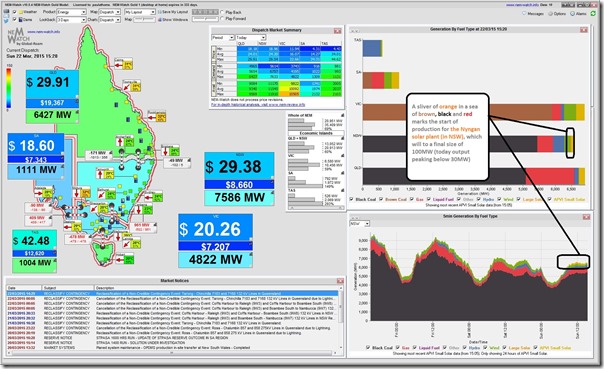Being the first large-scale solar farm in the NEM for which AEMO is publishing data (smaller plant, like Royalla, do not have data published by AEMO), it’s worth providing this historical record on WattClarity.
The AEMO-published SCADA generation reading for Nyngan first stepped up off zero at 13:50 (NEM time) on Saturday 21st March 2015 (so 14:50 local time onsite). Here’s a snapshot we grabbed from the new NEM-Watch v10 upgrade late on Sunday afternoon, showing the two different types of solar data feed now available through NEM-Watch:
Like many other energy-sector stakeholders, we will watch with interest to see how the ongoing growth in solar production progresses.



I’ll be very interested to know the average wholesale price of power from the solar farm. Royalla has contracted to sell electricity at $183/MWh (or there ablouts from memory). That’s about six times the average LCOE of existing coal plants (according to BREE AETA, 2012). and over three times the average spot price.
Of course all that is because the very large hidden subsidies and cross subsidies are included. What an unbelievable boondoggle solar and wind power are. And for what purpose? What effect will they have on the climate?
Talk about being short-sighted. By very definition we’ll have to phase over to renewables eventually, the sooner we start the better.
Clearly you don’t live anywhere near a coal fired power plant. The number of environmental hazards they pose is extensive, that’s excluding their massive CO2 output. Coal is cheap because there are unpriced externalities. It’s that simple.
As for solar subsidies, a recent (Nov. 2014) ABC News article stated that: “Australian coal, oil and gas companies receive $4b in subsidies”.
There’s no hidden subsidy or cross-subsidy here, it’s pretty overt.
Also, that contract price is the same as the cost of nukes, except it’s a fixed cost not rising with inflation.